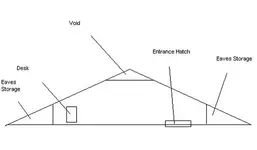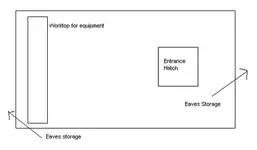T
theguit
New member
hi everyone. Im looking for advice on my studio project. I have an attic that im converting to a small recording/mixing studio. The attic has a false floor (joisted to the brickwork rather than straight to the ceiling below), and is bare to the blockwork and joists. Im going to be converting it to a proper room so im at a point where i can alter the rooms shape. ie. build bass traps into the corners? are there any advantages to this rather than installing bass traps at a later date. if so, best way to build them? i will be battening out the walls and installing insulation, then plasterboard. same for the ceiling. I have included some quickly drawn up plans, (without dimensions though im afraid, however can easily get it all measured) but imagine the size big enough to get a car in! I do however have alot of stuff that needs storing so when i build the room i will be including access points to the eaves. There is also a dormer window central to the room above the desk.
The use for my studio will be, recording, mixing, and general jams with friends. i have a roland electric kit so can record direct or midi, guitar amp with a great sounding record out, good sounding di output from bass amp also, so am hoping the only micing up im going to need is vocals and some acoustic instruments.
With this in mind, i want to get the best setup for mixing that i can. By my reckoning, the angled ceilings work to my advantage as any early reflection points on the ceiling will be directed into the room rather than to my ears. Another point may be, do i need to bother boarding and plastering the room? apart from external noises (and if im not doing much mic-ing?), and cosmetics! the acoustics dont seem to bad in there. it feels fairly dead when i do the good old clap test (nothing noticable anyway).
Any help and advice is greatly appreciated, i have searched extensively on google for anything similar to my setup but to no avail! all other attic studios seem to be orientated the other way round!
Ta
The use for my studio will be, recording, mixing, and general jams with friends. i have a roland electric kit so can record direct or midi, guitar amp with a great sounding record out, good sounding di output from bass amp also, so am hoping the only micing up im going to need is vocals and some acoustic instruments.
With this in mind, i want to get the best setup for mixing that i can. By my reckoning, the angled ceilings work to my advantage as any early reflection points on the ceiling will be directed into the room rather than to my ears. Another point may be, do i need to bother boarding and plastering the room? apart from external noises (and if im not doing much mic-ing?), and cosmetics! the acoustics dont seem to bad in there. it feels fairly dead when i do the good old clap test (nothing noticable anyway).
Any help and advice is greatly appreciated, i have searched extensively on google for anything similar to my setup but to no avail! all other attic studios seem to be orientated the other way round!
Ta
Attachments
Last edited:







 Soooooooo, carry on. and good luck.
Soooooooo, carry on. and good luck.